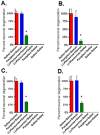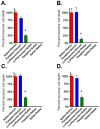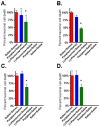(-)-Phenserine attenuates soman-induced neuropathology
- PMID: 24955574
- PMCID: PMC4067273
- DOI: 10.1371/journal.pone.0099818
(-)-Phenserine attenuates soman-induced neuropathology
Abstract
Organophosphorus (OP) nerve agents are deadly chemical weapons that pose an alarming threat to military and civilian populations. The irreversible inhibition of the critical cholinergic degradative enzyme acetylcholinesterase (AChE) by OP nerve agents leads to cholinergic crisis. Resulting excessive synaptic acetylcholine levels leads to status epilepticus that, in turn, results in brain damage. Current countermeasures are only modestly effective in protecting against OP-induced brain damage, supporting interest for evaluation of new ones. (-)-Phenserine is a reversible AChE inhibitor possessing neuroprotective and amyloid precursor protein lowering actions that reached Phase III clinical trials for Alzheimer's Disease where it exhibited a wide safety margin. This compound preferentially enters the CNS and has potential to impede soman binding to the active site of AChE to, thereby, serve in a protective capacity. Herein, we demonstrate that (-)-phenserine protects neurons against soman-induced neuronal cell death in rats when administered either as a pretreatment or post-treatment paradigm, improves motoric movement in soman-exposed animals and reduces mortality when given as a pretreatment. Gene expression analysis, undertaken to elucidate mechanism, showed that (-)-phenserine pretreatment increased select neuroprotective genes and reversed a Homer1 expression elevation induced by soman exposure. These studies suggest that (-)-phenserine warrants further evaluation as an OP nerve agent protective strategy.
Conflict of interest statement
Figures






Similar articles
-
Exposure to nerve agents: from status epilepticus to neuroinflammation, brain damage, neurogenesis and epilepsy.Neurotoxicology. 2012 Dec;33(6):1476-1490. doi: 10.1016/j.neuro.2012.09.001. Epub 2012 Sep 7. Neurotoxicology. 2012. PMID: 23000013 Review.
-
Acetylcholinesterase inhibition in the basolateral amygdala plays a key role in the induction of status epilepticus after soman exposure.Neurotoxicology. 2013 Sep;38:84-90. doi: 10.1016/j.neuro.2013.06.006. Epub 2013 Jun 29. Neurotoxicology. 2013. PMID: 23817175
-
A rat model of nerve agent exposure applicable to the pediatric population: The anticonvulsant efficacies of atropine and GluK1 antagonists.Toxicol Appl Pharmacol. 2015 Apr 15;284(2):204-16. doi: 10.1016/j.taap.2015.02.008. Epub 2015 Feb 15. Toxicol Appl Pharmacol. 2015. PMID: 25689173 Free PMC article.
-
Effective countermeasure against poisoning by organophosphorus insecticides and nerve agents.Proc Natl Acad Sci U S A. 2006 Aug 29;103(35):13220-5. doi: 10.1073/pnas.0605370103. Epub 2006 Aug 16. Proc Natl Acad Sci U S A. 2006. PMID: 16914529 Free PMC article.
-
Ketamine combinations for the field treatment of soman-induced self-sustaining status epilepticus. Review of current data and perspectives.Chem Biol Interact. 2013 Mar 25;203(1):154-9. doi: 10.1016/j.cbi.2012.09.013. Epub 2012 Oct 5. Chem Biol Interact. 2013. PMID: 23044489 Review.
Cited by
-
Cognitive Impairments Induced by Concussive Mild Traumatic Brain Injury in Mouse Are Ameliorated by Treatment with Phenserine via Multiple Non-Cholinergic and Cholinergic Mechanisms.PLoS One. 2016 Jun 2;11(6):e0156493. doi: 10.1371/journal.pone.0156493. eCollection 2016. PLoS One. 2016. PMID: 27254111 Free PMC article.
-
(-)-Phenserine inhibits neuronal apoptosis following ischemia/reperfusion injury.Brain Res. 2017 Dec 15;1677:118-128. doi: 10.1016/j.brainres.2017.09.015. Epub 2017 Sep 27. Brain Res. 2017. PMID: 28963051 Free PMC article.
-
(-)-Phenserine and the prevention of pre-programmed cell death and neuroinflammation in mild traumatic brain injury and Alzheimer's disease challenged mice.Neurobiol Dis. 2019 Oct;130:104528. doi: 10.1016/j.nbd.2019.104528. Epub 2019 Jul 8. Neurobiol Dis. 2019. PMID: 31295555 Free PMC article.
-
Acetylcholinesterase Inhibitors in the Treatment of Neurodegenerative Diseases and the Role of Acetylcholinesterase in their Pathogenesis.Int J Mol Sci. 2021 Aug 27;22(17):9290. doi: 10.3390/ijms22179290. Int J Mol Sci. 2021. PMID: 34502198 Free PMC article. Review.
-
Midazolam-Resistant Seizures and Brain Injury after Acute Intoxication of Diisopropylfluorophosphate, an Organophosphate Pesticide and Surrogate for Nerve Agents.J Pharmacol Exp Ther. 2018 Nov;367(2):302-321. doi: 10.1124/jpet.117.247106. Epub 2018 Aug 16. J Pharmacol Exp Ther. 2018. PMID: 30115757 Free PMC article.
References
-
- Newmark J (2007) Nerve agents. Neurologist 13: 20–32. - PubMed
-
- Shih TM, Duniho SM, McDonough JH (2003) Control of nerve agent-induced seizures is critical for neuroprotection and survival. Toxicol Appl Pharmacol 188: 69–80. - PubMed
-
- Romano JA Jr, King JM (2001) Psychological casualties resulting from chemical and biological weapons. Mil Med 166 12 Suppl: 21–22. - PubMed
-
- Okumura T, Takasu N, Ishimatsu S, Miyanoki S, Mitsuhashi A, et al. (1996) Report on 640 Victims of the Tokyo Subway Sarin Attack. Annals of Emergency Medicine 28: 129–136. - PubMed
Publication types
MeSH terms
Substances
Grants and funding
LinkOut - more resources
Full Text Sources
Other Literature Sources
Medical
Miscellaneous

